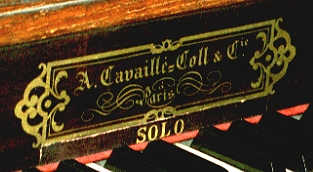

Aristide Cavaillé-Coll
|
|
Grand Orgue |
Positif |
Récit |
Pédale
Ventils | Review Quiz |
| Top of page
Grand Orgue | Positif | Récit | Pédale Ventils | Review Quiz |
The Grand OrgueThe Grand Orgue of the French Classical Organ was the primary manual division with regard to
Just in case all of these words have obscured a major point, here's a summary of the comparison of a traditional French Classical Grand Orgue to a Cavaillé-Coll Grand Orgue.
|
| Top of page
Grand Orgue | Positif | Récit | Pédale Ventils | Review Quiz |
| Top of page
Grand Orgue | Positif | Récit | Pédale Ventils | Review Quiz |
The RécitThe Récit of the French Classical organ was small, often containing a single stop, a Cornet V, with perhaps the addition of reed - - a Trompette or Hautbois. Its placement above the chest of the Grand Orgue, often on the same level as the mounted Cornet of that division, made it an equal partner with that stop. The Récit Cornet found its most frequent use either as a solo stop or in dialogue with the Grand jeu, where it provided the third dynamic level in those longer works of the repertory called - - appropriately enough - - Dialogues. A reed might be used in conjunction with the Cornet of the Récit or alone in a solo role. In essence, the Cavaillé-Coll Récit has the same functions, because its stops also fill solo roles. However, in addition to the traditional functions, the same division at the hand of Cavaillé-Coll took on new characteristics and new musical functions. Although the specific stops may vary from one instrument to the next, several different features of the Cavaillé-Coll Récit appear consistently from one instrument to the next.
|
| Top of page
Grand Orgue | Positif | Récit | Pédale Ventils | Review Quiz |
| Top of page
Grand Orgue | Positif | Récit | Pédale Ventils | Review Quiz |
| Top of page
Grand Orgue | Positif | Récit | Pédale Ventils | Review Quiz |
© 1999 James H. Cook